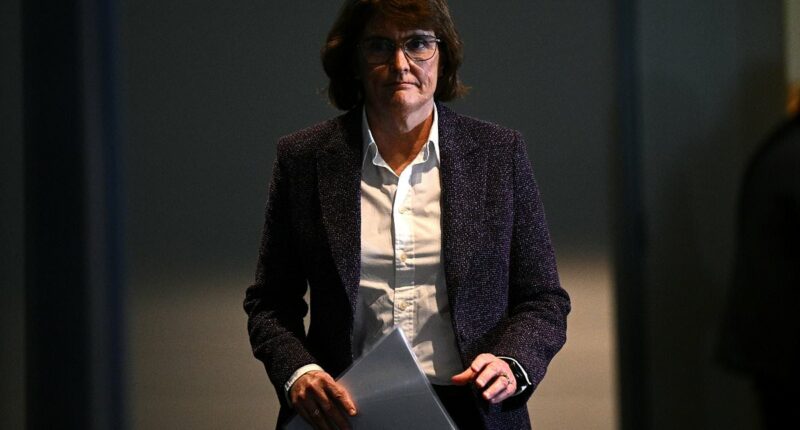Share this @internewscast.com
Australian homeowners with mortgages are facing the prospect of increased repayments as the likelihood of another interest rate rise looms. Recent developments have heightened these concerns, with the latest inflation data delivering a blow to any hopes of relief from the Reserve Bank.
On Wednesday, inflation figures revealed a rise in underlying inflation to 3% over the year leading up to September. This marks the most significant quarterly increase since March 2023. The unexpected rise has effectively quashed any possibility of a rate cut by the Reserve Bank in its upcoming meeting next Tuesday. Instead, economists are advising that the Bank may need to either maintain current rates or consider an increase to control inflation.
Paul Bloxham, HSBC’s chief economist, has dismissed the idea of further rate cuts and predicts that the Reserve Bank’s next major move will be a rate hike, expected in 2027.
“Interest rate cuts are off the table,” Bloxham informed The Australian. “The issue is that productivity is severely lacking, resulting in constrained supply. As input costs like labor and energy rise, there is no corresponding increase in output.”
Bloxham further explained, “We are anticipating rate hikes in 2027, with the expectation that they will begin in the first half of that year.”
‘We continue to see hikes in 2027, but we now expect them to begin in the first half of 2027.’
AMP deputy chief economist Diana Mousina said the latest inflation figures caught many economists off guard, marking the first increase since the peak of the inflation crisis in December 2022.
She expected the RBA will hold the cash rate at 3.6 per cent at both the upcoming November and December meetings but remained optimistic rates would be cut next year.

HSBC chief economist Paul Bloxham (pictured) expects the next big move by the Reserve Bank will be a rate hike in 2027 off the back of higher than expected inflation data

While the RBA is now widely expected to hold rates next week it must also consider the acute financial distress of Australian families say industry experts
‘It is surprising to see the tick up in inflation,’ she said.
‘Another rate cut had been expected at next week’s Board meeting, especially as the September labour force figures showed the unemployment rate rising to 4.5 per cent, from 4.3 per cent in the prior month and above the RBA’s forecasts.
‘Inflation can still track back down into the RBA’s target band rather than running above it, but it will take longer to get there than we had expected.’
Ms Mousina said December quarter inflation data is likely to be lower which could pave the way for a February rate cut.
‘Some economists and analysts will say that rate cuts are no longer needed and maybe debate the need for rate hikes,’ she said.
‘We think that lower interest rates are still required to support the labour market as interest rates are still at restrictive levels, but for now it makes sense to wait and see how the inflation data evolves.
‘There is no hurry on cutting interest rates.’
Ms Mousina said rate hikes posed some risk to first homebuyers who opted in to the federal government’s 5 per cent deposit scheme.

AMP deputy chief economist Diana Mousina (pictured) says rates cuts are still needed to support the labour market as the unemployment rate rises
‘First homebuyers would have been looking forward to the prospect of 1 to 2 more rate cuts from here and that probability has also fallen,’ she said.
She said the scheme always carried the risk of inadvertently exposing first homebuyers to greater financial vulnerability due to rising rates.
Real Estate Institute of Australia (REIA) president Leanne Pilkington said the RBA’s next move carries ‘significant consequences’ for mortgage holders.
‘We’re in a phase where the RBA’s next move carries real consequences for both confidence and affordability,’ she said.
Ms Pilkington said while the RBA is widely expected to hold rates this week, it must also consider the acute financial distress of Australian families.
The government’s fast-tracked first homebuyer scheme allows eligible first-home buyers to avoid lenders mortgage insurance while purchasing a home with just a 5 per cent deposit.
RBA boss Michele Bullock told a Senate economics committee earlier this month the federal government’s homebuyer scheme could push up property prices.
She also warned that if the housing market were to decline, first-home buyers who purchased under the scheme with high loan-to-value ratios could face serious risk -potentially owing more than their property is worth if prices fall.

RBA boss Michele Bullock (pictured) told a Senate economics committee first-home buyers who purchased under the scheme could potentially owing more than their property is worth
‘If they do find themselves in difficulties – there’s a risk that may not cover the loan,’ she said.
‘When you’ve got a high loan-to-valuation ratio, it doesn’t take as long for housing prices to decline and you’re in negative equity.’




